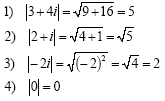|
Complex NumbersA complex number is an expression of the form x + iy where x and y are real numbers. Either x or y may be equal to zero: real numbers and imaginary numbers are special cases of complex numbers. Given a complex number z = x + iy the real number x is known as the real part of z and the real number y is known as the imaginary part of z. The notation Re is used for real part and Im is used for imaginary part.
Note that the imaginary part of z is a real number y (NOT iy).
Adding and Subtracting Complex NumbersTo add or subtract complex numbers, we add or subtract their real and imaginary parts separately:
Examples: 1) (2 + 3i) + (4 + i) = 6 + 4i 2) (3 - 5i) - 7i = 3 - 12i 3) (5 - 4i) + (3 + 2i) - (8 + i) = -3i 4) 12 - 4i + (3 + 4i) = 15
Multiplying complex numbersTo multiply complex numbers, we use the usual rules and the identity i2 = -1:
Examples:
The complex conjugateGiven a complex number z = x + iy, the complex conjugate is given by z* = x - iy (pronounced “z starâ€):
To find the complex conjugate of any expression, replace i by –i.
Examples: 1) (3 + 4i)* = 3 - 4i 2) (5 - 2i)* = 5 + 2i 3) (6i)* = -6i 4) [(2 + 4i)*]* = [2 - 4i]* = 2 + 4i
The last expression demonstrates that
A complex number and its complex conjugate have the property that:
Examples: 1) (3 + 4i) + (3 + 4i)* = 3 + 4i + 3 - 4i = 6 2) (3 + 4i) - (3 + 4i)* = 3 + 4i - 3 + 4i = 8i 3) 5i + (5i)* = 5i - 5i = 0 4) 5i - (5i)* = 10i
Complex conjugate of a product
The modulus of a complex numberA complex number z = x + iy multiplied by its complex conjugate is a real number:
The modulus of a complex number z = x + iy is written | z | and is equal to the positive square root of the sum of the squares of its real and imaginary parts:
Examples:
The modulus is a real number
The quotient of complex numbersIn order to simplify an expression with a complex number in the denominator, we multiply both the numerator and denominator by the complex conjugate:
In this way, we get a real number in the denominator (the modulus squared of a + bi).
Examples:
In general:
|
|





